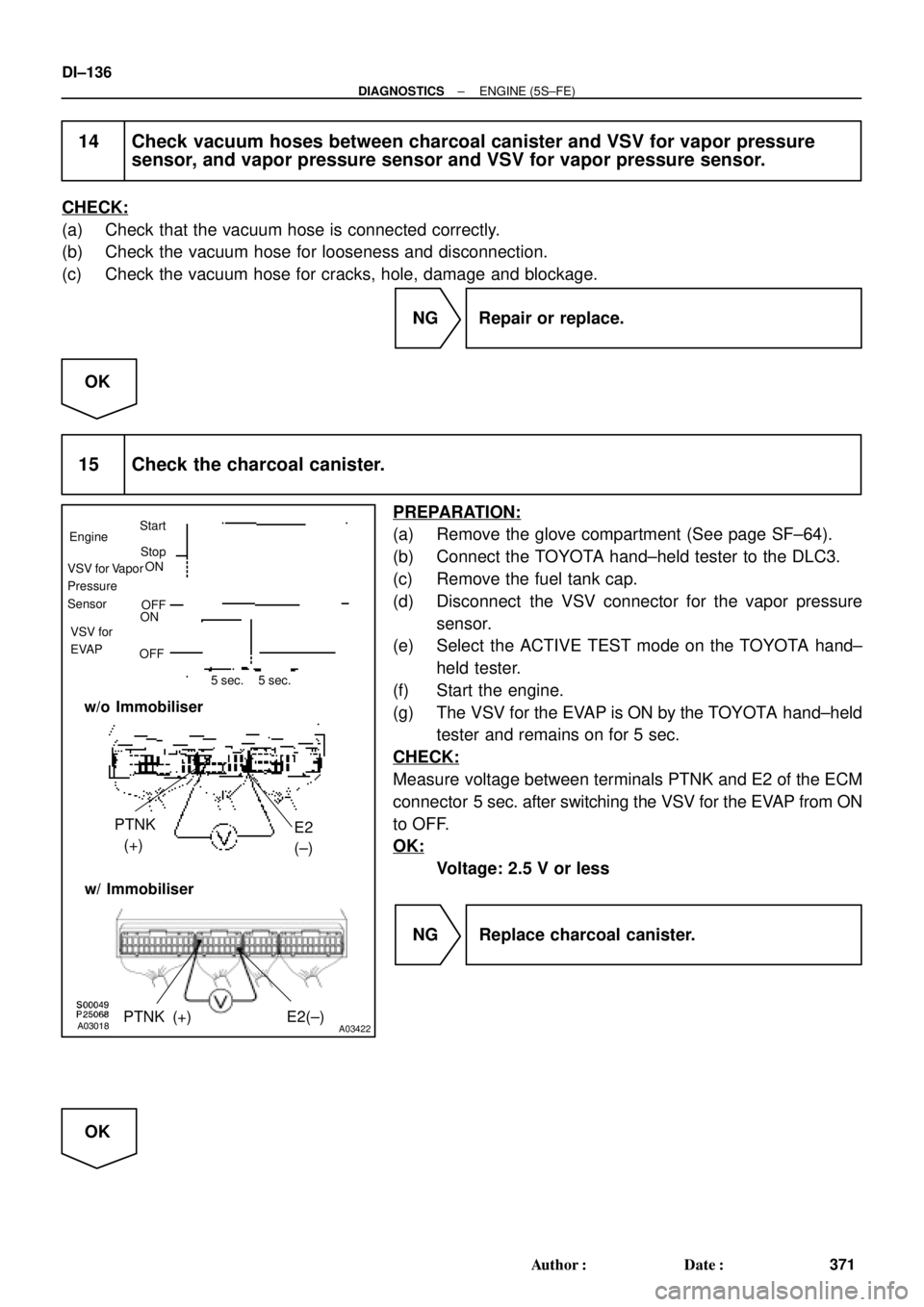Page 2556 of 4770

A03018A03422
ON EngineStart
Stop
VSV for Vapor
Pressure
Sensor
OFFOFF
ON
VSV for
EVAP
5 sec. 5 sec.
PTNK
(+)E2
(±) w/o Immobiliser
w/ Immobiliser
PTNK (+) E2(±)
DI±136
± DIAGNOSTICSENGINE (5S±FE)
371 Author�: Date�:
14 Check vacuum hoses between charcoal canister and VSV for vapor pressure
sensor, and vapor pressure sensor and VSV for vapor pressure sensor.
CHECK:
(a) Check that the vacuum hose is connected correctly.
(b) Check the vacuum hose for looseness and disconnection.
(c) Check the vacuum hose for cracks, hole, damage and blockage.
NG Repair or replace.
OK
15 Check the charcoal canister.
PREPARATION:
(a) Remove the glove compartment (See page SF±64).
(b) Connect the TOYOTA hand±held tester to the DLC3.
(c) Remove the fuel tank cap.
(d) Disconnect the VSV connector for the vapor pressure
sensor.
(e) Select the ACTIVE TEST mode on the TOYOTA hand±
held tester.
(f) Start the engine.
(g) The VSV for the EVAP is ON by the TOYOTA hand±held
tester and remains on for 5 sec.
CHECK:
Measure voltage between terminals PTNK and E2 of the ECM
connector 5 sec. after switching the VSV for the EVAP from ON
to OFF.
OK:
Voltage: 2.5 V or less
NG Replace charcoal canister.
OK
Page 2557 of 4770
± DIAGNOSTICSENGINE (5S±FE)
DI±137
372 Author�: Date�:
16 Remove charcoal canister and check it (See page EC±5)
NG Replace charcoal canister.
OK
17 Check fuel tank over fill check valve (See page EC±6).
NG Replace fuel tank over fill check valve or fuel
tank.
OK
Check and replace ECM (See page IN±31).
OBD II scan tool (excluding TOYOTA hand±held tester):
HINT:
If DTC P0441 (Evaporative Emission Control System Incorrect Purge Flow), P0446 (Evaporative Emission
Control System Vent Control Malfunction) or P0450 (Evaporative Emission Control System Pressure Sensor
Malfunction) is output after DTC P0440 (Evaporative Emission Control System Malfunction), first trouble-
shoot DTC P0441, P0446 or P0450. If no malfunction is detected, troubleshoot DTC P0440 next.
1 Check VSV connector for EVAP, VSV connector for vapor pressure sensor and
vapor pressure sensor connector for looseness and disconnection.
NG Repair or connect VSV or sensor connector.
OK
Page 2563 of 4770

± DIAGNOSTICSENGINE (5S±FE)
DI±143
378 Author�: Date�:
DTC No.DTC Detecting ConditionTrouble Area
P0450
10 seconds or more after engine starting codition (a) or (b)
continues for 7 seconds or more:
(2 trip detection logic)
(a) vapor pressure sensor value < ±4 kpa (±30 mmHg,
±1.0 in.Hg)
(b) Vapor pressure sensor value � 2.1 kpa (±15 mmHg,
0.4 in.Hg)
�Open or short in vapor pressure sensor circuit
�Vapor pressure sensor
�ECM
F l t k fill h k l k d d d
P0451
Vapor pressure sensor output extremely changes under condi-
tions of (a), (b) and (c):
(2 trip detection logic)
(a) Vehicle speed: 0 km/h (0 mph)
(b) Engine speed: idling
(c) VSV for vapor pressure sensor is ON�Fuel tank over fill check valve cracked or damaged.
WIRING DIAGRAM
Refer to DTC P0440 (Evaporative Emission Control System Malfunction) on page DI±122.
INSPECTION PROCEDURE
HINT:
�If DTC P0441 (Evaporative Emission Control System Incorrect Purge Flow), P0446 (Evaporative
Emission Control System Vent Control Malfunction), P0450 (Evaporative Emission Control System
Pressure Sensor Malfunction) or P0451 is output after DTC P0440 (Evaporative Emission Control Sys-
tem Malfunction), first troubleshoot DTC P0441, P0446, P0450 or P0451. If no malfunction is detected,
troubleshoot DTC P0440 next.
�Read freeze frame data using TOYOTA hand±held tester or OBD II scan tool. Because freeze frame
records the engine conditions when the malfunction is detected, when troubleshooting it is useful for
determining whether the vehicle was running or stopped, the engine warmed up or not, the air±fuel
ratio lean or rich, etc. at the time of the malfunction.
�When the ENGINE RUN TIME in the freeze frame data is less than 200 seconds, carefully check the
VSV for EVAP, charcoal canister and vapor pressure sensor.
1 Check voltage between terminals VC and E2 of ECM connector
(See page DI±122, step 9).
NG Check and replace ECM (See page IN±31).
OK
Page 2566 of 4770
DI±146
± DIAGNOSTICSENGINE (5S±FE)
381 Author�: Date�:
INSPECTION PROCEDURE
HINT:
Read freeze frame data using TOYOTA hand±held tester or OBD II scan tool. Because freeze frame records
the engine conditions when the malfunction is detected, when troubleshooting it is useful for determining
whether the vehicle was running or stopped, the engine warmed up or not, the air±fuel ratio lean or rich, etc.
at the time of the malfunction.
1 Check operation of speedometer.
CHECK:
Drive the vehicle and check if the operation of the speedmeter in the combination meter is normal.
HINT:
The vehicle speed sensor is operating normally if the speedometer display is normal.
NG Check speedometer circuit. See combination
meter troubleshooting (See page BE±2).
OK
Page 2569 of 4770

± DIAGNOSTICSENGINE (5S±FE)
DI±149
384 Author�: Date�:
INSPECTION PROCEDURE
HINT:
Read freeze frame data using TOYOTA hand±held tester or OBD II scan tool. Because freeze frame records
the engine conditions when the malfunction is detected, when troubleshooting it is useful for determining
whether the vehicle was running or stopped, the engine warmed up or not, the air±fuel ratio lean or rich, etc.
at the time of the malfunction.
1 Check idle speed.
PREPARATION:
(a) Warm up the engine to normal operating temperature.
(b) Switch off all the accessories.
(c) Switch off the air conditioning.
(d) Shift the transmission into N or neutral position.
(e) Connect the OBD II scan tool or TOYOTA hand±held tester to the DLC3 on the vehicle.
(f) Using SST, connect terminals TE1 and E1 of the DLC1.
CHECK:
Check the difference of engine speed between the ones less than 5 sec. and more than 5 sec. after connect-
ing terminals TE1 and E1 of the DLC1.
OK:
Difference of engine speed: More than 100 rpm
OK Go to step 6.
NG
Page 2572 of 4770

DI±152
± DIAGNOSTICSENGINE (5S±FE)
387 Author�: Date�:
DTC P1130 A/F Sensor Circuit Range/Performance
Malfunction (Only for California Spec.)
CIRCUIT DESCRIPTION
Refer to DTC P0125 (Insufficient Coolant Temp. for Closed Loop Fuel Control (Only for California Spec.))
on page DI±61.
DTC No.DTC Detecting ConditionTrouble Area
Voltage output* of A/F sensor remains at 3.8 V or more, or 2.8
V or less, during engine running after engine is warmed up (2
trip detection logic)
*: Output value changes at the inside of ECM only
P1130Voltage output* of A/F sensor does not change from 3.30 V,
during engine running after engine is warmed up
(2 trip detection logic)
*: Output value changes at inside of ECM only�Open or short in A/F sensor circuit
�A/F sensor
�ECM
Open or short in A/F sensor circuit
(2 trip detection logic)
HINT:
�After confirming DTC P1130, use the OBD II scan tool or TOYOTA hand-held tester to confirm voltage
output of A/F sensor (AFS B1 S1 / O2S B1 S1) from the CURRENT DATA.
�The A/F sensor's output voltage and the short-term fuel trim value can be read using the OBD II scan
tool or TOYOTA hand-held tester.
�The ECM controls the voltage of AF� and AF� terminals of ECM to the fixed voltage. Therefore, it
is impossible to confirm the A/F sensor output voltage without OBD II scan tool or TOYOTA hand±held
tester.
�OBD II scan tool (excluding TOYOTA hand-held tester) displays the one fifth of the A/F sensor output
voltage which is displayed on the TOYOTA hand-held tester.
WIRING DIAGRAM
Refer to DTC P0125 (Insufficient Coolant Temp. for Closed Loop Fuel Control (Only for California Spec.))
on page DI±61.
DI01D±06
Page 2573 of 4770

A00364
Vehicle Speed
60 ~ 120 km/h
(38 ~ 75 mph)
Idling
IG SW OFF
3 ~ 5 min.
Time
(1)(2)(4)
(3)
± DIAGNOSTICSENGINE (5S±FE)
DI±153
388 Author�: Date�:
CONFIRMATION DRIVING PATTERN
(1) Connect the TOYOTA hand±held tester to the DLC3.
(2) Switch the TOYOTA hand±held tester from normal mode to check mode (See page DI±3).
(3) Start the engine and warm it up with all accessory switches OFF.
(4) Drive the vehicle at 60 ~ 120 km/h (38 ~ 75 mph) and engine speed at 1,600 ~ 3,200 rpm for 3
~ 5 min.
HINT:
If a malfunction exists, the MIL will light up during step (4).
NOTICE:
If the conditions in this test are not strictly followed, detection of the malfunction will not be possible.
If you do not have a TOYOTA hand±held tester, turn the ignition switch OFF after performing steps
(3) and (4), then perform steps (3) and (4) again.
INSPECTION PROCEDURE
HINT:
Read freeze frame data using TOYOTA hand±held tester or OBD II scan tool. Because freeze frame records
the engine conditions when the malfunction is detected, when troubleshooting it is useful for determining
whether the vehicle was running or stopped, the engine warmed up or not, the air±fuel ratio lean or rich, etc.
at the time of the malfunction.
1 Are there any other codes (besides DTC P1130) being output?
YES Go to relevant DTC chart.
NO
Page 2574 of 4770

DI±154
± DIAGNOSTICSENGINE (5S±FE)
389 Author�: Date�:
2 Connect OBD II scan tool or TOYOTA hand±held tester, and read value for volt-
age output of A/F sensor.
PREPARATION:
(a) Connect the OBD II scan tool or TOYOTA hand±held tester to the DLC3.
(b) Warm up the A/F sensor with the engine at 2,500 rpm for approx. 90 sec.
CHECK:
Read voltage value of the A/F sensor on the screen of OBD II scan tool or TOYOTA hand±held tester when
you perform all the following conditions.
HINT:
The voltage of AF� terminal of ECM is 3.3 V fixed and AF� terminal is 3.0 V fixed. Therefore, it is impossible
to check the A/F sensor output voltage at the terminals (AF�/AF�) of ECM.
OK:
ConditionA/F Sensor Voltage Value
Engine idling
Engine racing�Not remains at 3.30 V (* 0.660 V)
�Not remains at38V(*0 76 V) or moreDriving at engine speed 1,500 rpm or more and vehicle
speed 40 km/h (25 mph) or more, and operate throttle valve
open and close�Not remains at 3.8 V (* 0.76 V) or more
�Not remains at 2.8 V (* 0.56 V) or less
*: When you use the OBD II scan tool (excluding TOYOTA hand±held tester)
HINT:
�During fuel enrichment, there is a case that the output voltage of the A/F sensor is below 2.8 V (* 0.56
V), it is normal.
�During fuel cut, there is a case that the output voltage of the A/F sensor is above 3.8 V (* 0.76 V), it
is normally.
�If output voltage of the A/F sensor remains at 3.30 V (* 0.660 V) even after performing all the above
conditions, A/F sensor circuit may be open.
�If output voltage of the A/F sensor remains at 3.8 V (* 0.76 V) or more, or 2.8 V (* 0.56 V) or less even
after performing all the above conditions, A/F sensor circuit may be short.
*: When you use the OBD II scan tool (excluding TOYOTA hand±held tester).
OK Go to step 9.
NG
3 Check for open and short in harness and connector between ECM and A/F sen-
sor (See page IN±31).
NG Repair or replace harness or connector.
OK